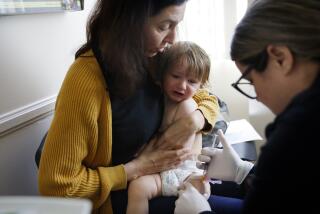To protect us all, vaccinate school kids
Flu vaccination season is nearly upon us, and doses of the vaccine are as abundant as traffic jams. But a flu vaccine shortage back in 2004 had us all wondering who should get the valuable resource to keep flu deaths and illnesses at a minimum.
*
For the record:
12:00 a.m. Nov. 11, 2006 For The Record
Los Angeles Times Saturday November 11, 2006 Home Edition Main News Part A Page 2 National Desk 3 inches; 115 words Type of Material: Correction
Flu: A Health section article Monday about flu vaccination suggested that Lauren Meyers, an integrative biologist at the University of Texas at Austin, said that, after high-risk groups, schoolchildren should be vaccinated next. In fact, Meyers’ research does not specifically advocate this strategy. She says that the next step should depend on the amount of vaccine available and the contagiousness of the circulating strains. The article also said the federal Centers for Disease Control and Prevention advises that children younger than 2 and the elderly should get flu shots. In fact, the CDC recommends that adults 50 and older get the shot, and also now recommends it for children 6 months to 5 years old.
For The Record
Los Angeles Times Monday November 13, 2006 Home Edition Health Part F Page 9 Features Desk 3 inches; 116 words Type of Material: Correction
Flu -- A Nov. 6 article about flu vaccination suggested that Lauren Meyers, an integrative biologist at the University of Texas at Austin, said that, after high-risk groups, schoolchildren should be vaccinated next. In fact, Meyers’ research does not specifically advocate this strategy. She says that the next step should depend on the amount of vaccine available and the contagiousness of the circulating strains. The article also stated that the federal Centers for Disease Control and Prevention advises that children younger than 2 and the elderly should get flu shots. The CDC recommends adults 50 years of age and older get the shot, and also now recommends it for children 6 months to 5 years old.
With this year’s cornucopia of flu vaccine, access won’t be a problem for the people who need it most: the elderly, children younger than 2, anyone with chronic illnesses, pregnant women, long-term care residents and healthcare workers in such facilities. The Centers for Disease Control and Prevention advises these groups to get flu shots in the hope of lowering deaths and hospitalizations.
Researchers have different opinions on which group should be targeted next. Some say that whoever wants it should get it: usually healthy adults who want to avoid the flu. Others say that focusing on school children is better. “School children are very important in sparking local outbreaks in communities,” says integrative biologist Lauren Meyers of the University of Austin at Texas.
Ira Longini, a professor of biostatistics at the University of Washington in Seattle, says that vaccinating most of the children in grades one through 12 is key to stopping the spread of flu and could have more of an effect on death and hospitalization rates than targeting the at-risk groups.
“If we can vaccinate roughly 70% of school children, [the number of cases] drops to really low levels and we can protect virtually the whole population,” Longini says. There is enough vaccine this year to do this and also cover high-risk groups, he adds.
Several lines of evidence support Longini’s view. From the late 1950s through the early 1990s, Japan vaccinated nearly all of the country’s schoolchildren -- and saw lower mortality in the elderly. As mass vaccinations declined, mortality rose. This suggests that fewer cases of the flu in general protects the older population, says Dr. Michael Rothberg, an internist at Tufts University in Boston.
Longini and his colleagues have examined the vaccinate-all-children strategy using computer models. Last February, they reported that vaccinating 20% of schoolchildren would reduce elderly deaths more than vaccinating 90% of people older than 65.
This is a tantalizing strategy because “we’ve ... been trying to reach the high-risk people, with limited success,” Longini says. Only 60% of those older than 65 get the vaccine, and it is less effective in elderly people, says Dr. Peter Gross, chair of the Department of Medicine at Hackensack University Medical Center in New Jersey.
A trial in Texas is testing this strategy. Researchers led by Dr. Pedro Piedra of Baylor College of Medicine in Houston are vaccinating many of the children in the town of Temple, Texas. They’ll then compare the rates of illness and death of Temple residents with those in other Texas towns.
Mary Beckman






